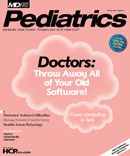Publication
Article
MDNG Pediatrics
Net Guide: Otitis Media
We searched the Internet for otitis media resources so you don't have to.
//The Educated Patient™
Ear Infections (Otitis Media) and Hearing Loss in Young Children
Distribute this handout to the parents of children with otitis media. Produced by the University of California, San Francisco’s Child Health Program, the material covers otitis media basics, situations in which a child should be excluded from activity, how to reduce the frequency of ear infections, how to care for a child with frequent ear infections and/or ear tubes, and the risks of hearing loss. The handout also includes a hearing checklist, allowing parents to monitor their child’s aural development from birth through three years of age.
Link Code: k8221
//Medical WebsitesChronic Suppurative Otitis Media
Use this article to brush up on otitis media basics, including epidemiology, clinical presentation, differential diagnosis, management, complications, prognosis, and the latest research. Though the editors caution that “PatientPlus articles are written for doctors and so the language can be technical,” they also note that the articles can “add depth to patient information leaflets.”
Link Code: k8211
Acute Otitis Media Patient Evaluation Primer
It’s unfortunate that this University of Texas Medical Branch activity is not available for CME credit, because working through all of the material found here can take some time. The site walks physicians through a patient evaluation (history-taking, otoscopy, TM anatomy, tympanometry); the severity grading system (body temperature, history, tympanometry, appearance of the tympanic membrane); various exercises (reading tympanograms, ranking tympanic membrane images according to severity, reviewing TM anatomy, etc.); expert and student discussion cases; and a review of all current acute otitis media literature cited in PubMed.
Link Code: k8212
Pedscases: Acute Otitis Media
Produced free-of-charge as part of Stollery Children’s Hospital’s Pedscases series, “this podcast gives medical students an overview of the diagnosis and treatment of acute otitis media.” Content is presented as “a discussion between Peter MacPherson, a medical student at the University of Alberta, and Dr. Sarah Forgie, a pediatric infectious disease specialist at the Stollery Children’s Hospital.”
Link Code: k8213
//eAbstractsAdenoidectomy and Nasopharyngeal Carriage of Streptococcus pneumonia in Young ChildrenJournal: Archives of Disease in Childhood (May 26, 2010)
Authors: Mattila P, Hammaren-Malmi S, Saxen H, et al.
Purpose: Because “the effect of adenoidectomy on nasopharyngeal colonization of pathogens has not previously been evaluated,” the authors decided to study the procedure’s effect on “colonization of bacteria causing otitis media and the effect of adenoidectomy on the development of pneumococcal capsular polysaccharide antibodies.”
Results: “Adenoidectomy increases the risk of nasopharyngeal carriage of pneumococci in children younger than four years of age. This may be independent of the development of serum IgG capsular polysaccharide antibodies.”
Link Code: k8251
Factors Associated with Acute Respiratory Illness in Day Care ChildrenJournal: Scandinavian Journal of Infectious Diseases (May 14, 2010)
Authors: Hatakka K, Piirainen L, Pohjavuon T, et al.
Purpose: Researchers sought to determine “the relationship between child characteristics, parental and environmental factors and the occurrence of acute respiratory illness (ARI) and acute otitis media (AOM) among Finnish children attending day care centres (DCCs).”
Results: Parental (child age, mother’s academic education, parent atopic disease, breastfeeding) and environmental factors (length of DCC attendance, ownership of a furry pet) “had significant impacton recurrent ARI and AOM episodes in children attending DCCs. These risk factors should be considered in future studies intending to reduce DCC infections.”
Link Code: k8252
How Do Parents of Preverbal Children with Acute Otitis Media Determine How Much Ear Pain theirChild Is Having?
Journal: The Journal of Pain (May 13, 2010)
Authors: Shaikh N, Kearney D, Colborn D, et al.
Purpose: Researchers “constructed eight cases describing a 1-year-old child with acute otitis media (AOM) using various combinations of the following six observable symptoms: fussiness, ear tugging, eating less, fever, sleeping difficulty, and playing less” to help parents determine whether their preverbal child is experiencing otalgia.
Results: “Each of the six behaviors was associated with increased pain levels,” though “ear tugging and fussiness had the highest impact on assigned pain levels.” The authors, however, “question the utility of using an overall pain score from a one-item parent scale as an outcome measure in clinical trials that include preverbal children,” because “interpretation of symptoms appears to be influenced by socioeconomic status.”
Link Code: k8253
//Clinical TrialsHomeopathic Ear Drops for Otitis Media StudyStudy Type: Interventional
Age/Gender Requirements: 6 months-11 years (male/female)
Sponsor: University of Washington
Purpose: Researchers are investigating whether Hyland’s earache drops are “effective in reducing symptoms in children six months-11 years old with acute otitis media in whom the health care provider has recommended that antibiotics not be immediately administered.”
Link Code: k8261
Xylitol Syrup for the Prevention of Acute Otitis Media in Otitis-prone ChildrenStudy Type: Interventional
Age/Gender Requirements: 6 months-5 years
Sponsor: Children’s Hospital of Boston
Purpose: Investigators will compare the efficacy and “safety of orally administered viscous-adherent xylitol syrup given in a dose of five grams three times daily for 12 weeks [to a placebo comparator] in reducing the incidence of clinically-diagnosed acute otitis media (ear infection) in children with a history of recurrent acute otitis media.”
Link Code: k8262
From the HCPLive.com Network
Watchful Waiting vs. Prescription Antibiotics in the Treatment of Acute Otitis Media
There’s a new battleground in the fight to curb antibiotic over-prescribing and control the spread of resistant superbugs: acute otitis media. Although a growing body of literature shows that most kids with ear infections recover with no complications without the use of antibiotics, many physicians continue to prescribe antibiotics for the vast majority of children diagnosed with an ear infection.
www.hcplive.com/pediatrics/articles/antibiotics_and_otitis_media
